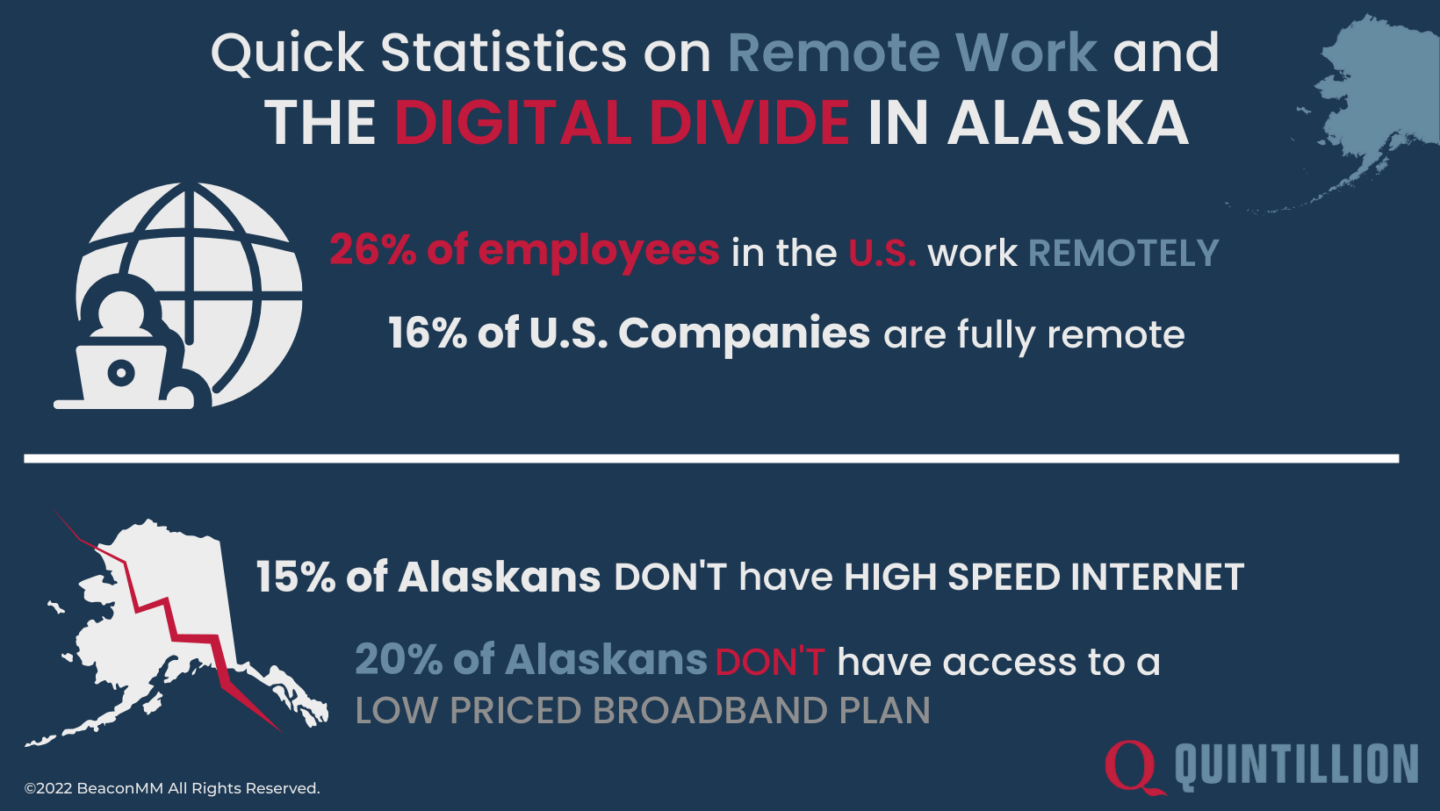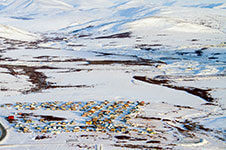Remote work has been on the rise in recent years. And while a majority of workers have returned to the workplace as pandemic regulations have eased, many businesses are still offering their employees remote work options. According to Zippia, as of 2022, 26% of employees in the U.S. work remotely, and 16% of U.S. companies are fully remote. With many large and notable businesses adopting a remote or hybrid work model — including Google, Amazon, Dell Technologies, and Spotify — there are new flexible job opportunities for many Americans.
However, the digital divide is still a significant challenge for many Alaskans in rural areas, and the lack of access to high-speed internet can limit job opportunities, educational attainment, and overall quality of life. 2023 statistics show that approximately 15% of Alaskans don’t have access to high-speed internet of at least 25 Mbps download and 3 Mbps upload speeds, and that 20% of Alaskans don’t have access to a low-priced broadband plan of $60/month or less.

Fiber technology is helping bridge the digital divide in Alaska by bringing the gold standard of connectivity to underserved and unserved rural Alaskan communities. And with the introduction of high-speed affordable internet services to these regions comes a wealth of opportunities for residents.
The Gold Standard of Connectivity: Why Rural Alaskan Communities Need Fiber Internet
Across the globe, fiber optic cables are currently the primary source of broadband. This is because fiber optic internet is relatively affordable, has an estimated lifespan of at least 25 years, and provides superior service.
Fast, Reliable Internet Service
Fiber optic cables are unbeatable when it comes to bandwidth capacity, latency, and data speeds. To be considered “high-speed internet,” the service must be able to provide speeds of at least 25 Mbps download and 3 Mbps. Fiber optic internet far exceeds these standards with speeds up to 1 Gbps, and sometimes more. Additionally, fiber is reliable in extreme weather conditions and is unaffected by electromagnetic interference.
Improved Economy
Fiber technology is also helping to boost local economies in Alaskan communities. In addition to enabling Alaskans to find remote work opportunities outside of their community, fiber facilitates economic growth in every area. With improved broadband, schools, government organizations, and tribal entities have increased access to digital resources that can dramatically improve outcomes for residents. Additionally, more and more residents will have internet access in their homes. This opens a wide range of opportunities for personal development, entrepreneurship, online education, telehealth services, research, entertainment, and a stronger connection to the outside world.
Fiber can also enhance the capabilities of already existing businesses. Mining, oil and gas, retail and grocery stores, construction, agriculture, wildlife management, research, forestry, healthcare, education, and essentially every industry can benefit from having access to digital tools that can streamline and enhance processes. With fiber, businesses can expand their reach and access new markets, leading to increased economic growth and prosperity for the community.
More Educational Opportunities
A flourishing work economy begins with the emerging workforce. If students are limited in the careers they can pursue, they will either choose from the jobs available or relocate to a city with more opportunities.
However, with fiber, there are limitless opportunities for students to pursue career paths previously closed to them. Local schools and colleges will be able to offer more diverse educational programs, and students can also pursue alternate degrees through online colleges. As students are encouraged and provided with the resources to pursue careers in new industries and bring new businesses to their community, they will continue to open new job opportunities for other residents.
Improved Health and Well-Being
Access to health and mental health services is very limited in underserved regions of Alaska. Poor access to healthcare has a severe and lasting impact on rural communities, including high rates of substance abuse and suicide, poor life expectancy, increased health concerns (such as obesity and diabetes), and a high number of accidental injuries and preventable hospitalizations.
Fiber enables residents to take advantage of telehealth for healthcare services they can’t access in their community. With improved access to healthcare services, residents can improve their outcomes. Additionally, many remote workers report remote work has significantly boosted their mental health. With a flexible work environment, individuals have more opportunities to prioritize self-care, attend regular doctor or therapy sessions, and spend more time with loved ones.
How Quintillion Is Bringing New Opportunities to Alaskan Communities
As the first telecommunications provider to build a subsea and terrestrial fiber optic cable network in the Alaska Arctic, Quintillion is paving the way for remote work in rural Alaskan communities that previously had no access to fiber internet. The current network covers a total span of 1700 miles and currently serves the Alaska markets of Nome, Kotzebue, Point Hope, Wainwright, Utqiaġvik, and Prudhoe Bay/Deadhorse – with future extensions in planning.
Opening New Doors
By bringing high-speed internet to rural Alaskan communities — in partnership with local ISPs, Alaska Native corporations, and government entities — Quintillion has opened the door to a wealth of opportunities:
- Advancing Public Health and Safety: High-speed broadband enhances capabilities for law enforcement, emergency personnel, and medical institutes to improve the welfare of Arctic people and communities. This includes enabling telehealth appointments, providing medical facilities access to state-of-the-art technology, improving emergency response, promoting health-related education, and more.
- Supporting Vital Industries: Fiber is transforming the Arctic’s most profitable and vital industries. With internet connection reaching some of the most remote parts of Alaska, those in mining, oil and gas, transportation, construction, and other core industries are benefiting from improved communication, data analysis, sophisticated tools, and more.
- Improving Education: Quintillion partners with educational institutions, such as Iḷisaġvik College, to ensure educators and students are equipped with the bandwidth necessary to support positive student outcomes.
- Stimulating Economic Growth: Quintillion’s network supports remote work, online learning, workforce training, e-commerce, and more, providing community members with many new career opportunities for entrepreneurship or outside employment.
Building Awareness
Quintillion strives to bring awareness to the digital divide’s impact on rural Alaskans and directly supports organizations that serve Alaska communities, including the Iron Dog Race, the Arctic Education Foundation, ANVCA, Alaska Community Foundation, and Iḷisaġvik College. Quintillion also works in close partnership with the communities it serves, including working with community liaisons that help it facilitate communication, build relationships, and hear the needs of residents and organizations.
Bridging the Digital Divide in Alaska
Fiber has opened the door to remote work opportunities in rural Alaskan communities and is enabling Alaskans to build in-demand, digital skills and consider new career options. With the digital divide becoming increasingly relevant, fiber is helping bridge the gap and equip communities with the technology they need to thrive.
Want to learn more Quintillion’s subsea fiber optic cable system and how it’s brining the gold standard of connectivity to the Alaska Arctic? Contact our team to get in touch or read the Quintillion blog to stay on top of the latest industry news.















